西北农林科技大学:《农业昆虫学》课程教学课件(英文版,2012)Chapter 1 Population dynamics and mechanism of pest insects

Chapter 1 Population Dynamics and Mechanisms of Pest Insects Wu Junxiang Li Yiping Junxw@nwsuaf.edu.cn yp2003@126.com
Chapter 1 Chapter 1 Population Dynamics and Population Dynamics and Mechanisms of Pest Insects Mechanisms of Pest Insects Wu Junxiang Junxiang & Li Yiping Junxw@nwsuaf.edu.cn lyp2003@126.com
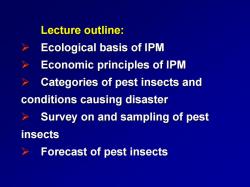
Lecture outline: Ecological basis of IPM Economic principles of IPM Categories of pest insects and conditions causing disaster >Survey on and sampling of pest insects Forecast of pest insects
Lecture outline: Lecture outline: ¾ Ecological basis of IPM Ecological basis of IPM ¾ Economic principles of IPM Economic principles of IPM ¾ Categories of pest insects and Categories of pest insects and conditions causing disaster conditions causing disaster ¾ Survey on and sampling of pest Survey on and sampling of pest insects insects ¾ Forecast of pest insects Forecast of pest insects

I.Ecological basis of IPM Ecosystem Environment Population growth Competifion
Ⅰ. Ecological basis of IPM Ecological basis of IPM 9Ecosystem Ecosystem 9Environment Environment 9Population growth Population growth 9Competition Competition
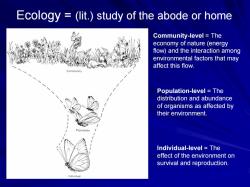
Ecology (lit.)study of the abode or home Community-level The economy of nature (energy flow)and the interaction among environmental factors that may affect this flow. Community Population-level The distribution and abundance of organisms as affected by their environment. Population Individual-level The effect of the environment on survival and reproduction. Individual
Ecology = (lit.) study of the abode or home Community-level = The economy of nature (energy flow) and the interaction among environmental factors that may affect this flow. Population-level = The distribution and abundance of organisms as affected by their environment. Individual-level = The effect of the environment on survival and reproduction
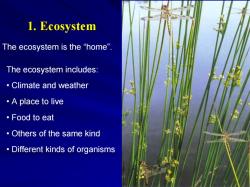
1.Ecosystem The ecosystem is the "home". The ecosystem includes: ·Climate and weather ·A place to live ·Food to eat Others of the same kind Different kinds of organisms
The ecosystem is the “home”. The ecosystem includes: • Climate and weather • A place to live • Food to eat • Others of the same kind • Different kinds of organisms 1. Ecosystem 1. Ecosystem
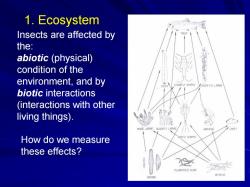
1.Ecosystem Insects are affected by the: abiotic (physical) condition of the environment,and by CADDIS-FLY LARVAE biotic interactions (interactions with other living things). MOSE LA BLACXFLY LARVA How do we measure MAYFLY NYMPHS these effects? FILAMENTOUS ALGAE DET南TUS
Insects are affected by the: abiotic (physical) condition of the environment, and by biotic interactions (interactions with other living things). How do we measure these effects? 1. Ecosystem

2.Environment 1)Niche A species'place in the environment is its niche the set of environmental conditions under which individuals can exploit resources effectively enough to reproduce
1) Niche A species’ place in the environment is its niche = the set of environmental conditions under which individuals can exploit resources effectively enough to reproduce. 2. Environment 2. Environment
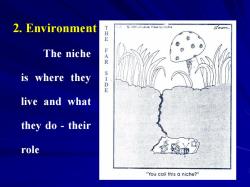
2.Environment 2 E The niche is where they E live and what they do their role "You call this a niche?
The niche is where they live and what they do - their role 2. Environment 2. Environment
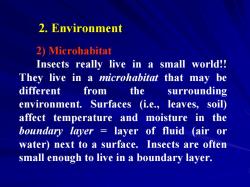
2.Environment 2)Microhabitat Insects really live in a small world!! They live in a microhabitat that may be different from the surrounding environment.Surfaces (i.e.,leaves,soil) affect temperature and moisture in the boundary layer layer of fluid (air or water)next to a surface.Insects are often small enough to live in a boundary layer
2) Microhabitat Insects really live in a small world!! They live in a microhabitat that may be different from the surrounding environment. Surfaces (i.e., leaves, soil) affect temperature and moisture in the boundary layer = layer of fluid (air or water) next to a surface. Insects are often small enough to live in a boundary layer. 2. Environment 2. Environment

2.Environment Microhabitat Insects also live in microhabitats that are protected from outside conditions: Inside plants -stem borers,leaf miners,gall makers ·In soil-grubs,ants In water-dragonfly nymphs, mosquito larvae,caddisflies In association with animals (under fur,in burrows,etc.)-lice,fleas In hives or nests bees,termites
• Inside plants - stem borers, leaf miners, gall makers • In soil - grubs, ants • In water - dragonfly nymphs, mosquito larvae, caddisflies • In association with animals (under fur, in burrows, etc.) - lice, fleas • In hives or nests - bees, termites 2. Environment - Microhabitat Insects also live in microhabitats that are protected from outside conditions:
按次数下载不扣除下载券;
注册用户24小时内重复下载只扣除一次;
顺序:VIP每日次数-->可用次数-->下载券;
- 西北农林科技大学:《农业昆虫学》课程教学课件(英文版,2012)Introduction.pdf
- 西北农林科技大学:《农业昆虫学》课程教学资源(历年真题)2009-2010学年农业昆虫学课程考试试卷A卷答案.pdf
- 西北农林科技大学:《农业昆虫学》课程教学资源(历年真题)2009-2010学年农业昆虫学课程考试试卷A卷.pdf
- 西北农林科技大学:《农业昆虫学》课程教学资源(历年真题)2009-2010学年农业昆虫学课程考试试卷B卷答案.pdf
- 西北农林科技大学:《农业昆虫学》课程教学资源(历年真题)2009-2010学年农业昆虫学课程考试试卷B卷.pdf
- 西北农林科技大学:《农业昆虫学》课程教学资源(历年真题)2008-2009学年农业昆虫学课程考试试卷A卷答案.pdf
- 西北农林科技大学:《农业昆虫学》课程教学资源(历年真题)2008-2009学年农业昆虫学课程考试试卷A卷.pdf
- 西北农林科技大学:《农业昆虫学》课程教学资源(历年真题)2008-2009学年农业昆虫学课程考试试卷B卷答案.pdf
- 西北农林科技大学:《农业昆虫学》课程教学资源(历年真题)2008-2009学年农业昆虫学课程考试试卷B卷.pdf
- 西北农林科技大学:《农业昆虫学》课程教学资源(历年真题)2007-2008学年农业昆虫学课程考试试卷A卷答案.pdf
- 西北农林科技大学:《农业昆虫学》课程教学资源(历年真题)2007-2008学年农业昆虫学课程考试试卷A卷.pdf
- 西北农林科技大学:《农业昆虫学》课程教学资源(历年真题)2007-2008学年农业昆虫学课程考试试卷B卷答案.pdf
- 西北农林科技大学:《农业昆虫学》课程教学资源(历年真题)2007-2008学年农业昆虫学课程考试试卷B卷.pdf
- 西北农林科技大学:《农业昆虫学》课程教学资源(历年真题)2006-2007学年农业昆虫学课程考试试卷B卷.pdf
- 西北农林科技大学:《农业昆虫学》课程教学资源(历年真题)2006-2007学年农业昆虫学课程考试试卷A卷.pdf
- 西北农林科技大学:《农业昆虫学》课程教学资源(历年真题)2005-2006学年农业昆虫学课程考试试卷A卷答案.pdf
- 西北农林科技大学:《农业昆虫学》课程教学资源(历年真题)2005-2006学年农业昆虫学课程考试试卷A卷.pdf
- 西北农林科技大学:《农业昆虫学》课程教学资源(历年真题)2005-2006学年农业昆虫学课程考试试卷B卷答案.pdf
- 西北农林科技大学:《农业昆虫学》课程教学资源(历年真题)2005-2006学年农业昆虫学课程考试试卷B卷.pdf
- 西北农林科技大学:《农业昆虫学》课程实验指导(打印版)实验十四 果树害虫鉴定(二).pdf
- 西北农林科技大学:《农业昆虫学》课程教学课件(英文版,2012)Chapter 2 Principles and Methods of IPM.pdf
- 西北农林科技大学:《农业昆虫学》课程教学课件(英文版,2012)Chapter 3 Ground Pest Insects.pdf
- 西北农林科技大学:《农业昆虫学》课程教学课件(英文版,2012)Chapter 4 Locusts.pdf
- 西北农林科技大学:《农业昆虫学》课程教学课件(英文版,2012)Chapter 5 Migratory and Polyphagous pest insects.pdf
- 西北农林科技大学:《农业昆虫学》课程教学课件(英文版,2012)Chapter 6 Aphids.pdf
- 西北农林科技大学:《农业昆虫学》课程教学课件(英文版,2012)Chapter 7 Scale insects.pdf
- 西北农林科技大学:《农业昆虫学》课程教学课件(英文版,2012)Chapter 8 Other sucking insect Pests.pdf
- 西北农林科技大学:《农业昆虫学》课程教学课件(英文版,2012)Chapter 9 Mites.pdf
- 西北农林科技大学:《农业昆虫学》课程教学课件(英文版,2012)Chapter 10 Foliage feeders(1).pdf
- 西北农林科技大学:《农业昆虫学》课程教学课件(英文版,2012)Chapter 10 Foliage feeders(2).pdf
- 西北农林科技大学:《农业昆虫学》课程教学课件(英文版,2012)Chapter 11 Foliage-mining pests.pdf
- 西北农林科技大学:《农业昆虫学》课程教学课件(英文版,2012)Chapter 12 Leaf-curling Insect Pests.pdf
- 西北农林科技大学:《农业昆虫学》课程教学课件(英文版,2012)Chapter 13 Stem Borers.pdf
- 西北农林科技大学:《农业昆虫学》课程教学课件(英文版,2012)Chapter 14 Branch borers.pdf
- 西北农林科技大学:《农业昆虫学》课程教学课件(英文版,2012)Chapter 15 Fruit borers.pdf
- 西北农林科技大学:《农业昆虫学》课程教学课件(英文版,2012)Chapter 16 Product-Stored Pests.pdf
- 西北农林科技大学:《农业昆虫学》课程教学课件(英文版,2012)Chapter 17 IPM of Cereal Crops.pdf
- 西北农林科技大学:《农业昆虫学》课程教学课件(英文版,2012)Chapter 18 IPM of cotton, hemp, tobacco and beet.pdf
- 西北农林科技大学:《农业昆虫学》课程教学课件(英文版,2012)Chapter 19 Integrated Pest Management of Oil Crops.pdf
- 西北农林科技大学:《农业昆虫学》课程教学课件(英文版,2012)Chapter 20 IPM of Vegetables.pdf
